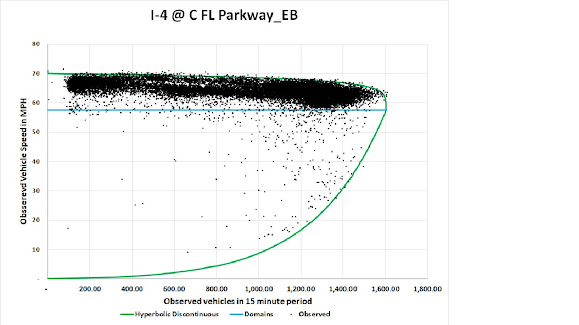Compared to What?
I love the lie and lie
the love
A-Hangin' on, with push and shove
Possession is the motivation
That is hangin' up the God-damn nation
Looks like we always end up in a rut (everybody now!)
Tryin' to make it real, compared to what? C'mon baby!
Real compared to Imaginary?
Euler’s formula, eix=cos(x)+sin(x)*i,
can be multiplied by a variable r on each side of the equal sign. It then becomes r*eix=r*cos(x)+r*sin(x)*i. This is also the statement of a complex number
in polar coordinates where r is the radius in polar coordinates and x
is the angle of rotation of the imaginary axis. In Cartesian, rectangular, coordinates, this
is a+b*i, where a = r*cos(x) and b=r*sin(x). The angle x, is tan-1(r*sin(x)/(r*cos(x)))
which is simply x The radius in polar coordinates
is r2=r2*cos2(x)+r2*sin2(x). This is traditionally solved as r=√(a2+b2)=r*√(cos2(x)+sin2(x))
where a = r*cos(x) and b=r*sin(x). Because of the identity for a circle, cos2(x) +
sin2(x)=1 for all x, this means r=r, and
thus the square root is the solution on a flat surface for all
values of x and is the formula on a spherical surface when the radius of the spsherical surface is very large compared to the polar radius.
However this is not the solution on a hyperbolic surface. This has the solution r=cosh‑1(cosh(a)*cosh(b)). When sin(0)=0 and cos(0)=1, this also has the
solution r*ei0=r +0*i and since ei0=1,
this also means r2=r2 and thus r=r. But sin(π) is also zero, but cos(π)=-1
this means that as a complex number r*eiπ=-r+0*i. This can only be solved by the hyperbolic
cosine and requires that r=ln(cosh(-r) ± sinh(-r)). If -r is further replaced by –(x2+y2),
this becomes ln(cosh(x2+y2) ± sinh(x2+y2)). The single solution on a flat or spherical
surface, when the coefficient of the imaginary axis is 0 and the angle of rotation
of the imaginary axis is π, becomes a logarithm of cosh(x2+y2), the constant term, plus or minus an uncertainty, which is sinh(x2+y2), on a hyperbolic surface. However if the uncertainty is greater than the constant term, the logarithm is NOT imaginary. It is undefined.
If a light cone is constructed which has three dimensions:
space, time, and imagination, and space is measured on an absolute scale, i.e.
there are no negative numbers, then the surface that light follows defines the
edge of that volume. The prohibition against
negative numbers is merely an indication that the position in space is a vector,
not a scalar. The surface may not be
flat, but may be hyperbolic. If that surface is hyperbolic, then the volume is
not a cone connected to an inverted cone at the origin, but a two-sheeted hyperboloid
where the two sheets connect at a single point at the origin.
The position in space as a vector is the velocity as a vector
multiplied by time, v*t. As a scalar
this is often expressed as v*t, with the provision that v>0. This effectively combines the dimensions of space,
x, with that of time, t.
Reality is defined as the position on the imaginary axis where i=0. Thus the expression v*t+0*i is a statement
of a position in real spacetime. With v*t
= a and with b=0, this is a complex number. Using the conversion of a complex number in Cartesian
coordinates, to one in polar coordinates this is reix=a+b*i where
x is tan-1(b/a) and r2=a2+b2. According to Euler’s Formula, there are two
solutions when the coefient of the imaginary axis is 0: rei0=v*t+0*i, where r2=(v*t)2+02
and tan‑1(0/(v*t))=0; and reiπ=-v*t+0*i where r2=(‑v*t)2+02 and tan-1(0/(-v*t))=π. If r is on a flat, Euclidean, surface,
r could be solved by Pythagoras’ Theorem. However while t can be positive or negative,
sin(x), the coefficient of the imaginary axis is cyclical, which means
that while x can be positive or negative, it is properly x=n*π where
n can be positive or negative and has a maximum and minimum value at integer
multiples of π.
Einstein’s Theory of Realitivity can be derived from Einstein’s
Triangle, (mc2)2=(mvc)2+(m0c2)2,
where v is the velocity of a particle, m is the relativistic mass of a
particle, m0 is the rest mass of that particle, and c
is the speed of light. This is conventionally
solved on a flat, Euclidean, surface, but if Einstein’s Triangle is solved for
a hyperbolic surface, the correct formulation would be
m=m0* ln(cosh(1-v2/c2)±sinh(1-v2/c2))
or
v=c*ln(cosh(1-m/m0)±sinh(1-m/m0))
If the Cartesian coordinates
are converted to polar coordinates, and x is an integer multiple of π,
then the polar radius can be solved as
r=ln(cosh(-v*t))*cosh(n*π) ± sinh(-v*t) * sinh(n*π)).
Further if cosh(n*π)=0 and sinh(n*π)=-1, since sinh(-x)=-sinh(x), then this
can be stated as
r=ln(0±sinh(v*t)))
Since sinh(x)=-cos(i*x), while the radius can be defined
as the natural logarithm of a regular cyclical trigonometric function, that function
only repeats, is cyclical, in imaginary, not real, planes. It is a single value in the real plane where the coefficient of the imaginary axis is zero.
